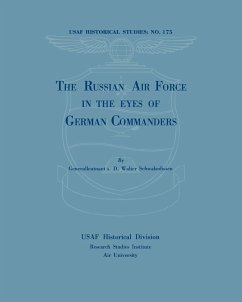When Germany initiated Operation Barbarossa against the Soviet Union in April 1941, the Soviet air forces were inferior to the Luftwaffe in virtually every respect save numerical strength. By 1944-1945, however, Soviet air power exercised almost uncontested air superiority. How and in what timeframe did this dramatic turnaround occur? This question is answered in "The Russian Air Force in the Eyes of German Commanders", one of a series of historical studies written by, or based on information supplied by, former key officers of the German Air Force for the United States Air Force Historical Division. After an introductory section describing the development and German appraisal of Soviet air power prior to Operation Barbarossa, the book provides a detailed account of German perceptions of Soviet fighter, bomber, reconnaissance, ground-air attack, special air operations, airborne, and other capabilities from the onset of war until the end of 1941 and followed by an examination of the 1942 through 1943 period, at which point a shift in power ratios in favor of the Soviets began and then accelerated through the end of the war. The final section details the achievement of air superiority rather than air supremacy by 1945. Soviet successes on the ground and in air warfare, Soviet numerical superiority, progress in technology, and the increasing combat experience of Soviet airmen, combined with declining German resources in both men and materials, signaled the onset of Soviet air superiority. This did not indicate a decline in German skill or courage, but rather the inevitable grinding down of German resources. As in the past however, Soviet air forces were employed mainly in support of ground forces, and the strategic use of air power remained limited, albeit much improved since the beginning of the war. Given the marked inferiority of Soviet air forces at the beginning of the Soviet-German conflict, The Russian Air Force in the Eyes of German Commanders is a remarkable story of rapid numerical and experiential growth in almost unbelievably adverse conditions. This important study by its adversaries is still of great value to strategists and historians interested in the development of modern air power in war. Originally published in 1960: 450 p. ill.








